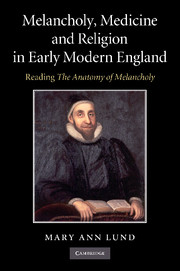Book contents
- Frontmatter
- Contents
- Acknowledgements
- Abbreviations
- A Note on Citation
- Introduction: Zisca's Drum: Reading and Cure
- Chapter 1 Imagining Readings
- Chapter 2 The Cure of Despair: Reading the End of The Anatomy of Melancholy
- Chapter 3 Printed Therapeutics: The Anatomy of Melancholy and Early Modern Medical Writing
- Chapter 4 The Whole Physician
- Chapter 5 Speaking out of Experience
- Chapter 6 The Structure of Melancholy: From Cause to Cure
- Conclusion
- Bibliography
- Index
Chapter 2 - The Cure of Despair: Reading the End of The Anatomy of Melancholy
Published online by Cambridge University Press: 23 February 2010
- Frontmatter
- Contents
- Acknowledgements
- Abbreviations
- A Note on Citation
- Introduction: Zisca's Drum: Reading and Cure
- Chapter 1 Imagining Readings
- Chapter 2 The Cure of Despair: Reading the End of The Anatomy of Melancholy
- Chapter 3 Printed Therapeutics: The Anatomy of Melancholy and Early Modern Medical Writing
- Chapter 4 The Whole Physician
- Chapter 5 Speaking out of Experience
- Chapter 6 The Structure of Melancholy: From Cause to Cure
- Conclusion
- Bibliography
- Index
Summary
Burton portrays his readership as unknowable and diverse. While this depiction highlights the distance between the author and his readers, at the same time it brings to the text a sense of inclusion: no standards of an ideal reader are presented and no assumptions are made about who the reader should be. What are the effects on the text as a whole of this portrayal of the reader as invisible? As I will show in this chapter, the manner in which an early modern author imagines readers can have a significant bearing on the way that other aspects of the text are handled, such as its politics or theology. Burton's position on questions of religion in the Anatomy is inseparable from the reader-centred rhetoric which he employs to propound it. While recent historical work has done much to refine our understanding of Burton's thought in its context, it is important not to lose sight of the praxis-centred mode of the text as one seeks to understand his ideas. I do not wish to imply that the work is a straightforward manual or handbook, but rather to stress that the knowledge, ideas, and arguments within it are presented in the framework of the relationship between writer and reader, and should be understood as such. It is distorting to consider the ideas and theories in Burton's writing in isolation from his style, because it is through his construction of the reading process that Burton articulates his perspective on theology and medicine, among other topics, especially in his discourse on cure.
- Type
- Chapter
- Information
- Melancholy, Medicine and Religion in Early Modern EnglandReading 'The Anatomy of Melancholy', pp. 51 - 76Publisher: Cambridge University PressPrint publication year: 2010



